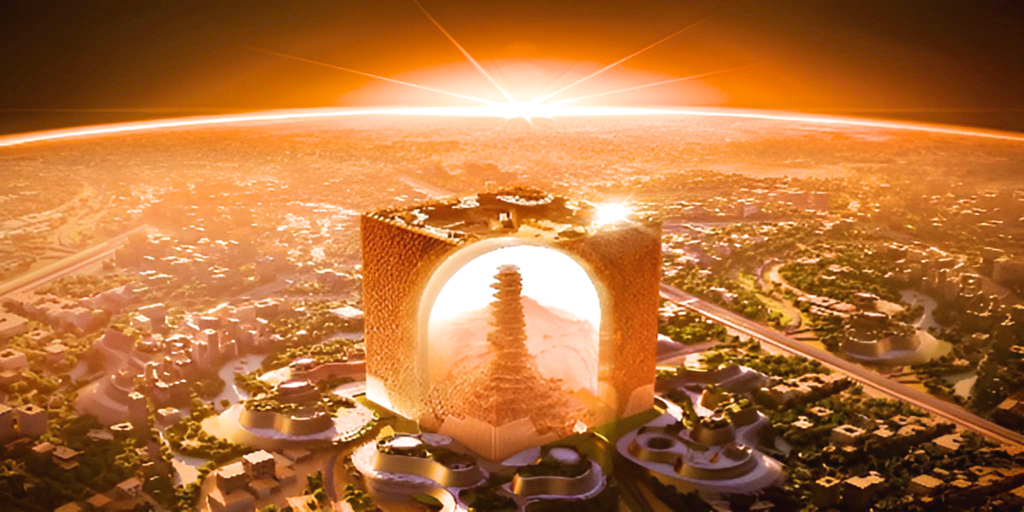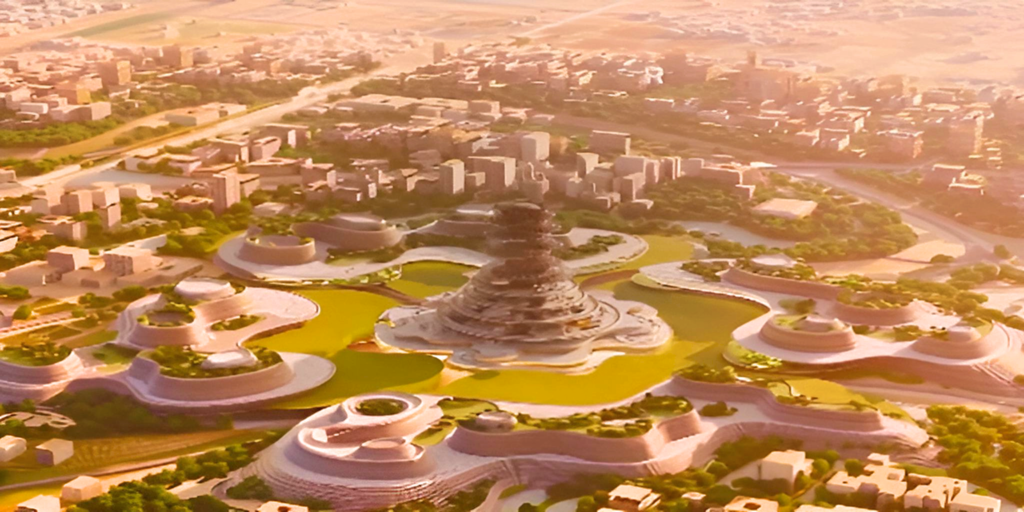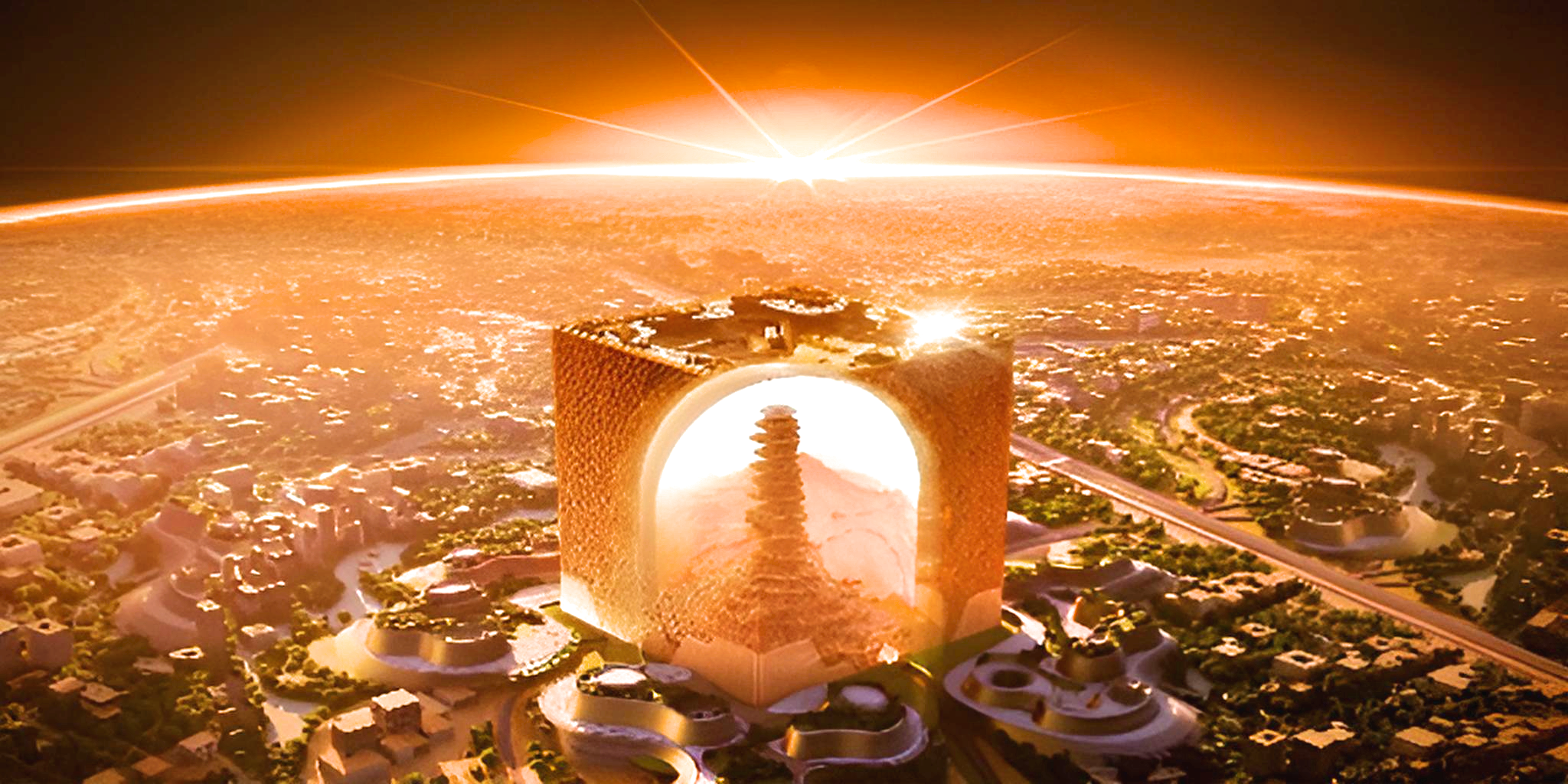Redefining Riyadh’s Skyline
Mukaab: Riyadh’s Architectural Marvel

Riyadh, the capital city of Saudi Arabia, is undergoing a remarkable transformation in its architectural landscape with the advent of Mukaab. Mukaab is a bold architectural endeavor that seeks to redefine Riyadh’s skyline and showcase the city’s modernity and grandeur. Built with the vision of creating a dynamic and vibrant metropolis, Mukaab is not only reshaping Riyadh’s physical appearance but also revolutionizing the way people perceive the city. Mukaab, which means “entrance” in Arabic, is a testament to the ambitious urban development plans set forth by the Arriyadh Development Authority. This innovative project combines modern building principles with regionalist designs, resulting in a distinctive and visually striking complex. The influence of historical factors in shaping Riyadh’s urban expansion cannot be overlooked It appears that the construction of King Abdul-Aziz’s palace north of the walled city set a prevailing pattern for the city’s growth. The Al-Murabba plan, in particular, played a noteworthy role in expanding the urban area and overcoming the limitations on physical expansion imposed by the old city walls. The impact of this expansion was not without its challenges. An important result of this urban expansion was the widespread suburbanization of Riyadh, which resulted in the decline of the city’s modern central area and the rise of dilapidated slums and housing for lower-income Saudi populations, as well as a vulnerable expatriate labor force from Third World countries. Against this context, Mukaab stands out as a symbol of advancement and creativity. With Riyadh’s ambitious Vision 2030, Mukaab serves as a symbol of the city’s commitment to becoming a world-class metropolis. By integrating modern building principles with regionalist designs, Mukaab embodies the harmonious blend of tradition and progressiveness that characterizes Saudi Arabia’s cultural heritage.
Inception and Vision behind Mukaab

Mukaab was conceived as part of the Arriyadh Development Authority’s urban renewal projects, which aimed to revitalize and transform Riyadh into a modern and cosmopolitan city. The development of Mukaab reflects the Authority’s vision to create a dynamic and sustainable urban environment that caters to the needs of its residents while preserving the rich cultural heritage of Saudi Arabia. The project’s name, “Mukaab,” meaning “entrance” in Arabic, is symbolic of its role as a gateway to the city and welcoming visitors with open arms.
Design Elements Shaping Mukaab’s Structure

The architectural design of Mukaab is a bold and innovative endeavor that redefines Riyadh’s skyline. The complex is characterized by its unique blend of modern and regionalist design elements, creating a visually striking and harmonious aesthetic. The use of modern building principles ensures that Mukaab meets the demands of contemporary urban living, while the incorporation of regionalist designs pays homage to Saudi Arabia’s rich architectural heritage. Elements such as the intricate geometric patterns, traditional mashrabiya screens, and the use of local materials like limestone reflect the cultural identity of Saudi Arabia in its design. Mukaab’s structure is also shaped by its functionality and efficiency. The architects behind Mukaab have carefully considered the needs and desires of the residents and visitors of Riyadh.
The complex encompasses a variety of amenities, including residential apartments, commercial spaces, recreational facilities, and green spaces.
Mukaab: A Solution to Urban Sprawl

Mukaab is not only a bold architectural endeavor but also a solution to the issue of urban sprawl that has plagued Riyadh in recent years. One significant outcome of the updated urban plan for Riyadh was a rapid suburbanization, resulting in an unprecedented urban sprawl. This extensive suburbanization not only harmed the city’s modernist core but also created a landscape of rundown slums and low-income housing. The launch of the Arriyadh Development Authority’s urban renewal projects, including Mukaab, sought to address this issue by integrating modern building principles with regionalist designs. Mukaab’s strategic location and comprehensive design aim to draw residents back to the city center, reducing the need for further suburban expansion. The incorporation of residential apartments within Mukaab allows for a diverse and vibrant community to thrive in the heart of the city. By creating a mixed-use development that combines residential, commercial, and recreational spaces, Mukaab promotes a sense of urban density and centrality. This not only reduces the financial burden on the government, which would have had to provide infrastructure and facilities for scattered suburban subdivisions, but also promotes a sustainable and orderly growth for the city.
Influence of Mukaab on Riyadh’s Skyline

Mukaab’s impact on Riyadh’s skyline is undeniable. With its towering structure and unique architectural features, Mukaab stands as a symbol of progress and modernity in the city. Its sleek facade and innovative design catch the eye, making it a standout feature in the urban landscape. Additionally, the functionality and efficiency of Mukaab’s design contribute to Riyadh’s evolving skyline.
The integration of residential, commercial, and recreational spaces not only creates a harmonious blend but also adds depth and character to the city’s skyline. The inclusion of green spaces within Mukaab further enhances its impact on Riyadh’s skyline. These green spaces serve as a contrast to the concrete jungle that often characterizes urban areas, providing a breath of fresh air and promoting a healthier and more sustainable environment.
Environmental Impact and Sustainability of Mukaab

In addition to its architectural significance, Mukaab also prioritizes environmental impact and sustainability. The concept of sustainability in architecture has become increasingly important, and Mukaab embodies this approach by incorporating various elements of sustainability in its design. Mukaab’s environmentally friendly features include energy-efficient systems, such as solar panels for power generation and rainwater harvesting for irrigation.
These features not only reduce the building’s carbon footprint but also promote a more sustainable and eco-friendlier lifestyle for its residents. Mukaab’s commitment to sustainability extends beyond its individual design features. The integrated and mixed-use nature of Mukaab promotes a sustainable and compact urban development model. By creating a central hub that combines residential, commercial, and recreational spaces in one location, Mukaab reduces the need for excessive transportation and commuting. This not only minimizes traffic congestion and air pollution but also encourages a more active and connected community. The impact of Mukaab on Riyadh’s skyline goes beyond its physical presence. The construction of Mukaab aligns with the goals set forth in Saudi Vision 2030, which emphasizes the development of smart cities and the integration of sustainability in all sectors of life.
Exploring the Interior Design of Mukaab

The interior design of Mukaab is equally impressive, combining functionality and aesthetics to create a unique and inviting space. The interior design of Mukaab is carefully curated to provide both functionality and aesthetics. The use of natural light and open spaces creates a sense of openness and transparency within the building, while also reducing the need for artificial lighting during the day.
The use of sustainable materials is also a key aspect of Mukaab’s interior design.Materials such as recycled wood, eco-friendly paints, and low-emission carpets are used to reduce the environmental impact of the building. Additionally, Mukaab’s interior design incorporates elements of biophilic design, which focuses on bringing nature into the built environment to promote wellbeing. For example, the incorporation of indoor plants, green walls, and natural materials such as wood and stone create a connection to nature within the urban setting of Mukaab. Furthermore, the interior design of Mukaab prioritizes energy efficiency and indoor environmental quality. Using advanced HVAC systems, efficient lighting fixtures, and proper insulation, Mukaab ensures a comfortable and healthy indoor environment while minimizing energy consumption and carbon emissions.
Mukaab’s Role in Redefining Riyadh’s Urban Landscape

With its innovative design and sustainable features, Mukaab is not just another skyscraper in Riyadh’s skyline. It stands as a bold architectural endeavor that redefines Riyadh’s urban landscape. Mukaab embodies the principles of sustainable smart cities, showcasing how architecture can contribute to the goals of Saudi Vision 2030. By integrating sustainable elements and embracing smart city principles, Mukaab sets a new standard for urban development in Riyadh. The implementation of smart cities in Riyadh, as outlined by Saudi Vision 2030, is crucial for achieving the vision’s goals of sustainable development. Mukaab’s design exemplifies the integration of sustainability, technology, and modern aesthetics to create a harmonious urban environment. From the perspective of urban design, Mukaab’s architecture incorporates the principles of a smart city and highlights the importance of landscape design.
The inclusion of green spaces and open areas within Mukaab’s design not only enhances the aesthetic appeal of the building but also promotes a more sustainable and ecologically friendly urban environment.
The Future Impact of Mukaab’s Bold Design on Global Architecture

Mukaab’s bold design is not only reshaping Riyadh’s skyline but also making a significant impact on global architecture.
By prioritizing sustainability and incorporating elements of biophilic design, Mukaab sets a new standard for future architectural endeavors. Its integration of passive design strategies, efficient systems, and sustainable materials serves as a model for creating energy-efficient and environmentally friendly buildings. This emphasis on sustainable design is particularly important as the concept of green building continues to gain traction worldwide. Furthermore, Mukaab’s focus on sustainable smart cities aligns with the global push for more environmentally conscious urban development. As a pioneering example of sustainable smart city design, Mukaab demonstrates how architecture can contribute to the betterment of the environment and future generations.
The Lasting Legacy of Mukaab in Riyadh’s Architectural History

In conclusion, Mukaab stands as a bold architectural endeavor that is redefining Riyadh’s skyline and setting new standards for sustainable smart city development. Its integrated design approach, incorporating elements of sustainability, technology, and modern aesthetics, showcases the possibilities of creating a harmonious urban environment. Mukaab’s emphasis on sustainable design, landscape integration, and smart city principles positions it as a significant project in the larger context of global architecture. With its innovative design and commitment to sustainability, Mukaab is not only reshaping Riyadh’s skyline, but also making a lasting impact on the architectural world. Furthermore, Mukaab’s transformative design and focus on sustainability will have far-reaching effects beyond Riyadh. It will serve as an inspiration for future architectural projects both in Saudi Arabia and around the globe, encouraging the integration of sustainability and smart city principles into urban planning and design. In the context of Saudi Vision 2030, smart cities development plays an important role in achieving the goals of the announced vision of Saudi Arabia.
